BP Oil Strategic Report: Environmental Analysis and Planning
VerifiedAdded on 2020/10/22
|20
|6877
|286
Report
AI Summary
This report provides a comprehensive strategic analysis of BP Oil Company, examining the impact of the macro environment using PESTEL analysis, and evaluating internal capabilities through the McKinsey 7s model and VRIO framework. It applies Porter's Five Forces to assess competitive pressures and utilizes the Ansoff Matrix to explore growth strategies. The report also formulates a strategic management plan, considering stakeholder analysis and SWOT, to enhance BP Oil's competitive advantage and ensure sustainable business practices in a dynamic global environment. Desklib provides students access to similar solved assignments and past papers.

BUSINESS
STRATEGY
STRATEGY
Paraphrase This Document
Need a fresh take? Get an instant paraphrase of this document with our AI Paraphraser

Table of Contents
INTRODUCTION...........................................................................................................................3
TASK 1............................................................................................................................................3
P1. Analysis of the impact of macro environment on an organization .................................3
D1. Analysis of environmental and competitiveness for production of strategic directions,
objectives and tactical actions for BP Oil...............................................................................4
TASK 2............................................................................................................................................7
P2. Analysis of internal environment and capabilities of BP oil............................................7
M2. Evaluation of internal environment to assess strengths and weaknesses of organization's
internal capabilities, structure and skill..................................................................................9
(a). Critical analysis of McKinsey 7s model analysis............................................................9
(b). VRIO Framework to analyse internal resources/capabilities structure and skill...........10
TASK 3..........................................................................................................................................12
P3. Application of Porter's Five Forces Model to evaluate competitive forces of BP Oil
company...............................................................................................................................12
M3. Analysis of BP oil by using Ansoff Matrix to improve competitive edge....................14
TASK 4..........................................................................................................................................14
P4. Application of range of theories, concepts and models along with interpretation and
formulation of strategic planning for BP oil.........................................................................14
M4. Strategic management plan for BP oil Company..........................................................17
CONCLUSION..............................................................................................................................18
REFERENCES..............................................................................................................................19
INTRODUCTION...........................................................................................................................3
TASK 1............................................................................................................................................3
P1. Analysis of the impact of macro environment on an organization .................................3
D1. Analysis of environmental and competitiveness for production of strategic directions,
objectives and tactical actions for BP Oil...............................................................................4
TASK 2............................................................................................................................................7
P2. Analysis of internal environment and capabilities of BP oil............................................7
M2. Evaluation of internal environment to assess strengths and weaknesses of organization's
internal capabilities, structure and skill..................................................................................9
(a). Critical analysis of McKinsey 7s model analysis............................................................9
(b). VRIO Framework to analyse internal resources/capabilities structure and skill...........10
TASK 3..........................................................................................................................................12
P3. Application of Porter's Five Forces Model to evaluate competitive forces of BP Oil
company...............................................................................................................................12
M3. Analysis of BP oil by using Ansoff Matrix to improve competitive edge....................14
TASK 4..........................................................................................................................................14
P4. Application of range of theories, concepts and models along with interpretation and
formulation of strategic planning for BP oil.........................................................................14
M4. Strategic management plan for BP oil Company..........................................................17
CONCLUSION..............................................................................................................................18
REFERENCES..............................................................................................................................19
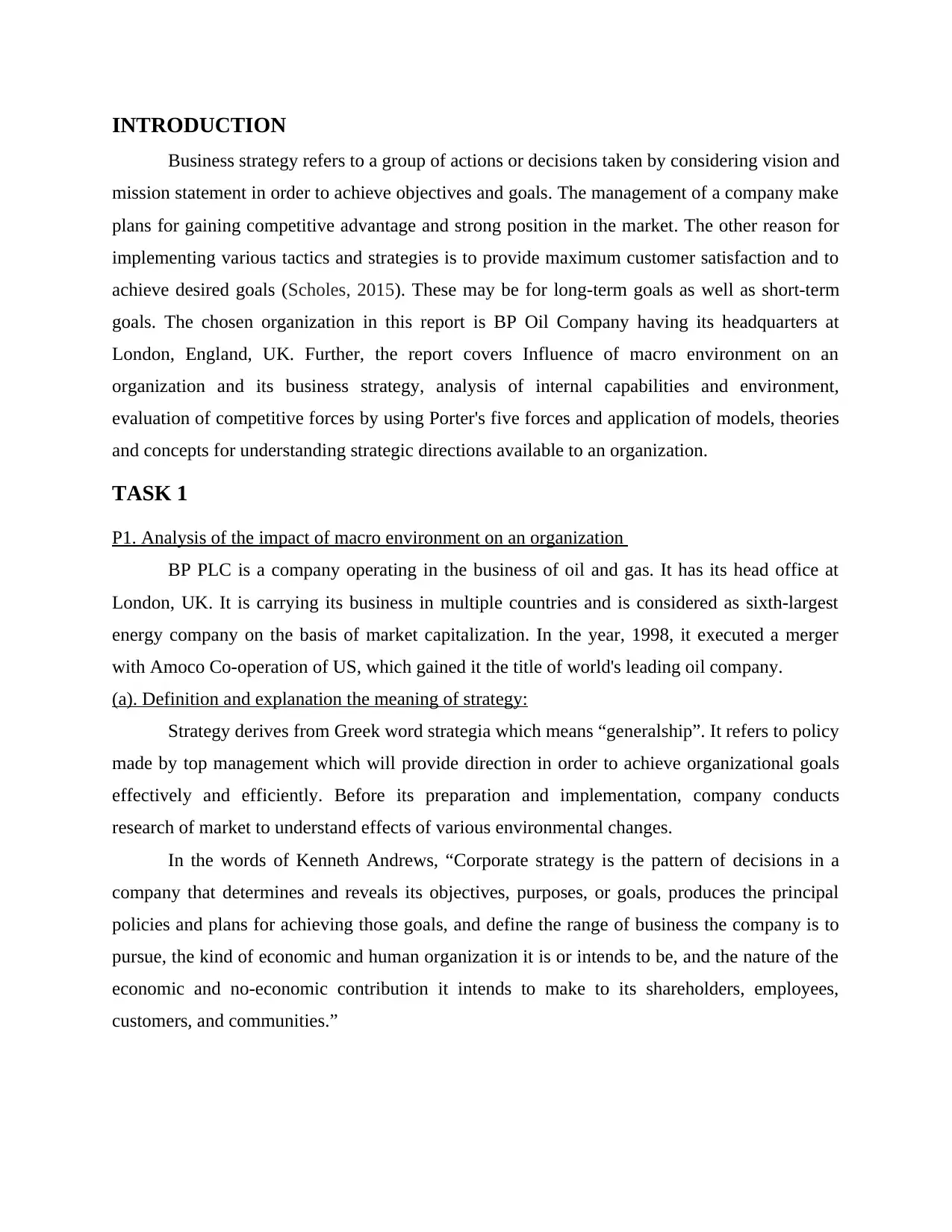
INTRODUCTION
Business strategy refers to a group of actions or decisions taken by considering vision and
mission statement in order to achieve objectives and goals. The management of a company make
plans for gaining competitive advantage and strong position in the market. The other reason for
implementing various tactics and strategies is to provide maximum customer satisfaction and to
achieve desired goals (Scholes, 2015). These may be for long-term goals as well as short-term
goals. The chosen organization in this report is BP Oil Company having its headquarters at
London, England, UK. Further, the report covers Influence of macro environment on an
organization and its business strategy, analysis of internal capabilities and environment,
evaluation of competitive forces by using Porter's five forces and application of models, theories
and concepts for understanding strategic directions available to an organization.
TASK 1
P1. Analysis of the impact of macro environment on an organization
BP PLC is a company operating in the business of oil and gas. It has its head office at
London, UK. It is carrying its business in multiple countries and is considered as sixth-largest
energy company on the basis of market capitalization. In the year, 1998, it executed a merger
with Amoco Co-operation of US, which gained it the title of world's leading oil company.
(a). Definition and explanation the meaning of strategy:
Strategy derives from Greek word strategia which means “generalship”. It refers to policy
made by top management which will provide direction in order to achieve organizational goals
effectively and efficiently. Before its preparation and implementation, company conducts
research of market to understand effects of various environmental changes.
In the words of Kenneth Andrews, “Corporate strategy is the pattern of decisions in a
company that determines and reveals its objectives, purposes, or goals, produces the principal
policies and plans for achieving those goals, and define the range of business the company is to
pursue, the kind of economic and human organization it is or intends to be, and the nature of the
economic and no-economic contribution it intends to make to its shareholders, employees,
customers, and communities.”
Business strategy refers to a group of actions or decisions taken by considering vision and
mission statement in order to achieve objectives and goals. The management of a company make
plans for gaining competitive advantage and strong position in the market. The other reason for
implementing various tactics and strategies is to provide maximum customer satisfaction and to
achieve desired goals (Scholes, 2015). These may be for long-term goals as well as short-term
goals. The chosen organization in this report is BP Oil Company having its headquarters at
London, England, UK. Further, the report covers Influence of macro environment on an
organization and its business strategy, analysis of internal capabilities and environment,
evaluation of competitive forces by using Porter's five forces and application of models, theories
and concepts for understanding strategic directions available to an organization.
TASK 1
P1. Analysis of the impact of macro environment on an organization
BP PLC is a company operating in the business of oil and gas. It has its head office at
London, UK. It is carrying its business in multiple countries and is considered as sixth-largest
energy company on the basis of market capitalization. In the year, 1998, it executed a merger
with Amoco Co-operation of US, which gained it the title of world's leading oil company.
(a). Definition and explanation the meaning of strategy:
Strategy derives from Greek word strategia which means “generalship”. It refers to policy
made by top management which will provide direction in order to achieve organizational goals
effectively and efficiently. Before its preparation and implementation, company conducts
research of market to understand effects of various environmental changes.
In the words of Kenneth Andrews, “Corporate strategy is the pattern of decisions in a
company that determines and reveals its objectives, purposes, or goals, produces the principal
policies and plans for achieving those goals, and define the range of business the company is to
pursue, the kind of economic and human organization it is or intends to be, and the nature of the
economic and no-economic contribution it intends to make to its shareholders, employees,
customers, and communities.”
⊘ This is a preview!⊘
Do you want full access?
Subscribe today to unlock all pages.

Trusted by 1+ million students worldwide
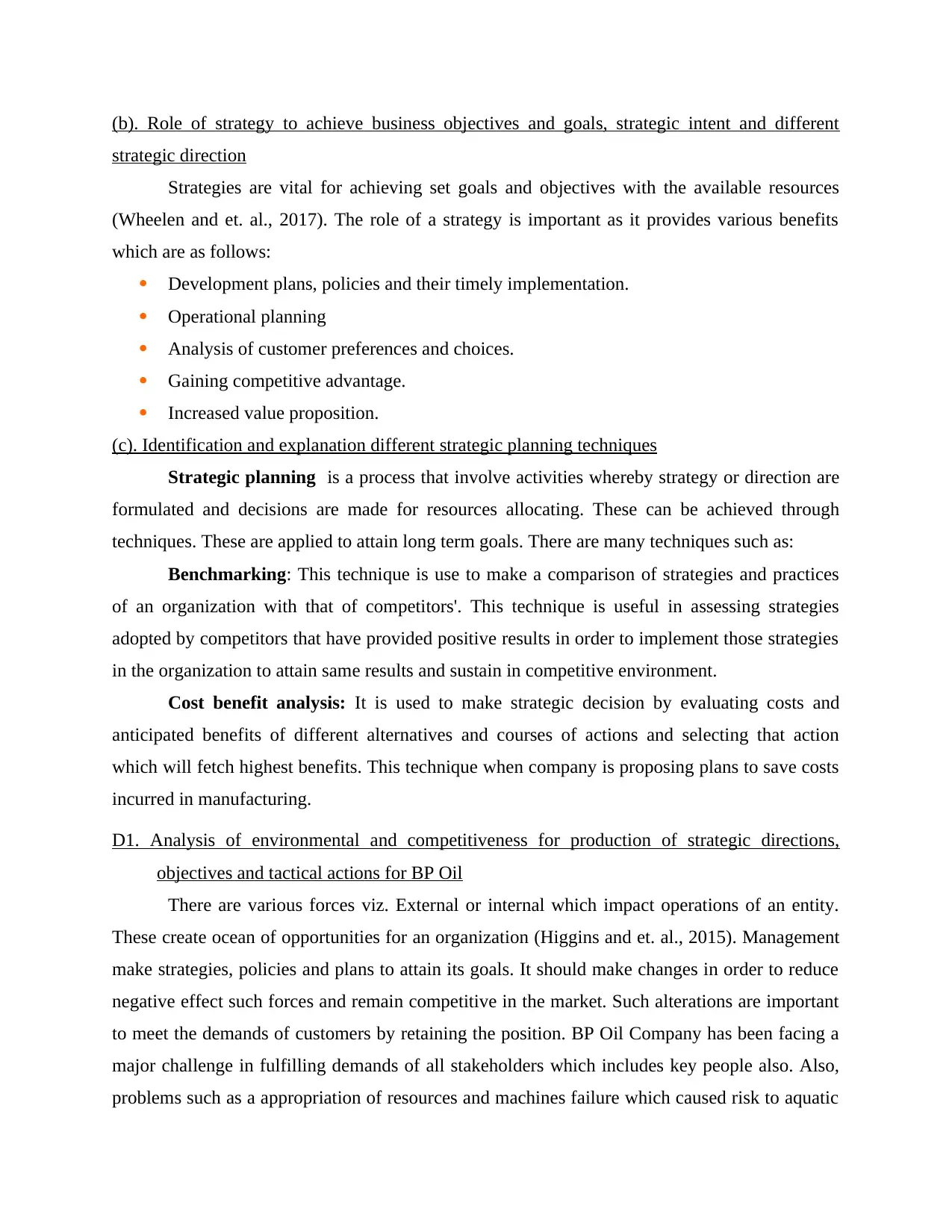
(b). Role of strategy to achieve business objectives and goals, strategic intent and different
strategic direction
Strategies are vital for achieving set goals and objectives with the available resources
(Wheelen and et. al., 2017). The role of a strategy is important as it provides various benefits
which are as follows:
Development plans, policies and their timely implementation.
Operational planning
Analysis of customer preferences and choices.
Gaining competitive advantage.
Increased value proposition.
(c). Identification and explanation different strategic planning techniques
Strategic planning is a process that involve activities whereby strategy or direction are
formulated and decisions are made for resources allocating. These can be achieved through
techniques. These are applied to attain long term goals. There are many techniques such as:
Benchmarking: This technique is use to make a comparison of strategies and practices
of an organization with that of competitors'. This technique is useful in assessing strategies
adopted by competitors that have provided positive results in order to implement those strategies
in the organization to attain same results and sustain in competitive environment.
Cost benefit analysis: It is used to make strategic decision by evaluating costs and
anticipated benefits of different alternatives and courses of actions and selecting that action
which will fetch highest benefits. This technique when company is proposing plans to save costs
incurred in manufacturing.
D1. Analysis of environmental and competitiveness for production of strategic directions,
objectives and tactical actions for BP Oil
There are various forces viz. External or internal which impact operations of an entity.
These create ocean of opportunities for an organization (Higgins and et. al., 2015). Management
make strategies, policies and plans to attain its goals. It should make changes in order to reduce
negative effect such forces and remain competitive in the market. Such alterations are important
to meet the demands of customers by retaining the position. BP Oil Company has been facing a
major challenge in fulfilling demands of all stakeholders which includes key people also. Also,
problems such as a appropriation of resources and machines failure which caused risk to aquatic
strategic direction
Strategies are vital for achieving set goals and objectives with the available resources
(Wheelen and et. al., 2017). The role of a strategy is important as it provides various benefits
which are as follows:
Development plans, policies and their timely implementation.
Operational planning
Analysis of customer preferences and choices.
Gaining competitive advantage.
Increased value proposition.
(c). Identification and explanation different strategic planning techniques
Strategic planning is a process that involve activities whereby strategy or direction are
formulated and decisions are made for resources allocating. These can be achieved through
techniques. These are applied to attain long term goals. There are many techniques such as:
Benchmarking: This technique is use to make a comparison of strategies and practices
of an organization with that of competitors'. This technique is useful in assessing strategies
adopted by competitors that have provided positive results in order to implement those strategies
in the organization to attain same results and sustain in competitive environment.
Cost benefit analysis: It is used to make strategic decision by evaluating costs and
anticipated benefits of different alternatives and courses of actions and selecting that action
which will fetch highest benefits. This technique when company is proposing plans to save costs
incurred in manufacturing.
D1. Analysis of environmental and competitiveness for production of strategic directions,
objectives and tactical actions for BP Oil
There are various forces viz. External or internal which impact operations of an entity.
These create ocean of opportunities for an organization (Higgins and et. al., 2015). Management
make strategies, policies and plans to attain its goals. It should make changes in order to reduce
negative effect such forces and remain competitive in the market. Such alterations are important
to meet the demands of customers by retaining the position. BP Oil Company has been facing a
major challenge in fulfilling demands of all stakeholders which includes key people also. Also,
problems such as a appropriation of resources and machines failure which caused risk to aquatic
Paraphrase This Document
Need a fresh take? Get an instant paraphrase of this document with our AI Paraphraser
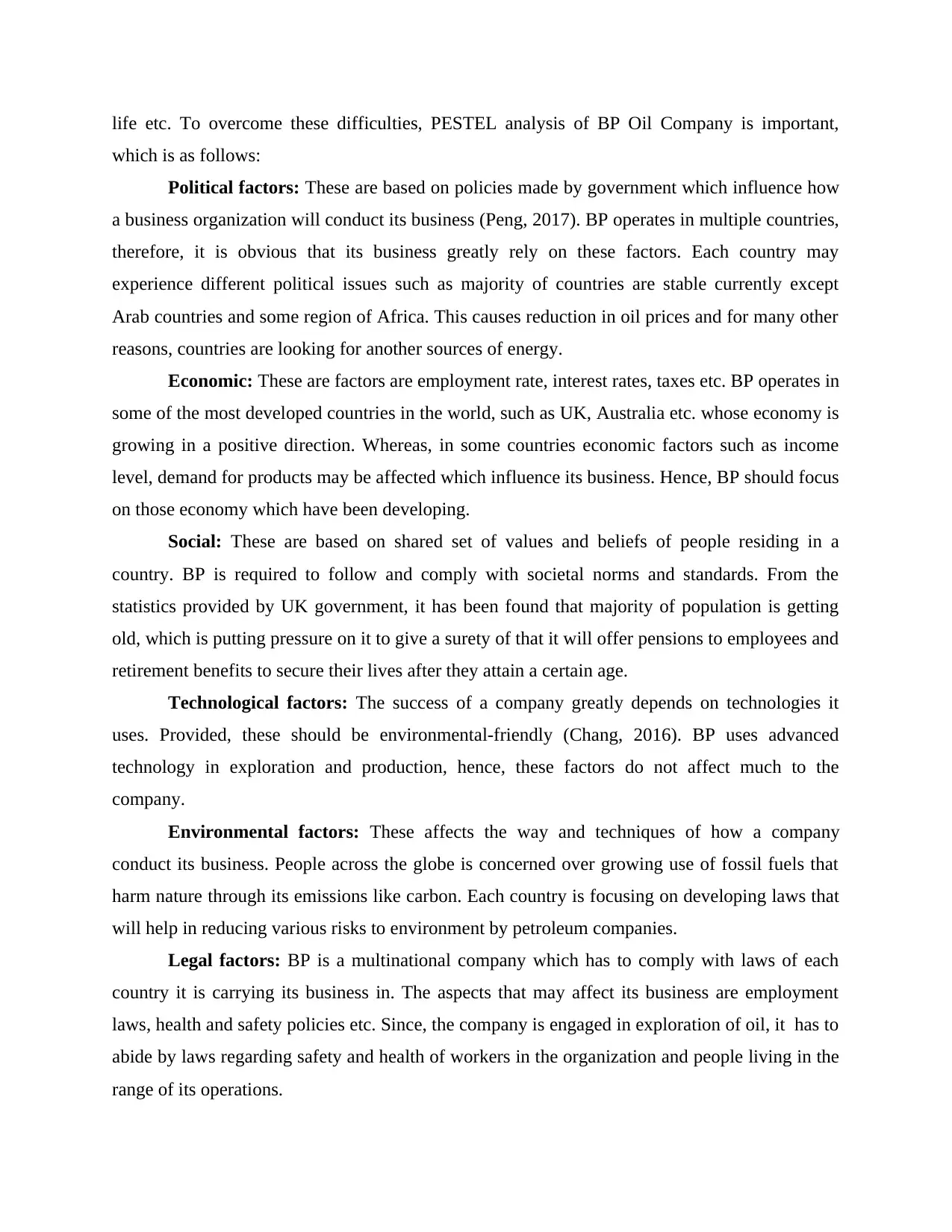
life etc. To overcome these difficulties, PESTEL analysis of BP Oil Company is important,
which is as follows:
Political factors: These are based on policies made by government which influence how
a business organization will conduct its business (Peng, 2017). BP operates in multiple countries,
therefore, it is obvious that its business greatly rely on these factors. Each country may
experience different political issues such as majority of countries are stable currently except
Arab countries and some region of Africa. This causes reduction in oil prices and for many other
reasons, countries are looking for another sources of energy.
Economic: These are factors are employment rate, interest rates, taxes etc. BP operates in
some of the most developed countries in the world, such as UK, Australia etc. whose economy is
growing in a positive direction. Whereas, in some countries economic factors such as income
level, demand for products may be affected which influence its business. Hence, BP should focus
on those economy which have been developing.
Social: These are based on shared set of values and beliefs of people residing in a
country. BP is required to follow and comply with societal norms and standards. From the
statistics provided by UK government, it has been found that majority of population is getting
old, which is putting pressure on it to give a surety of that it will offer pensions to employees and
retirement benefits to secure their lives after they attain a certain age.
Technological factors: The success of a company greatly depends on technologies it
uses. Provided, these should be environmental-friendly (Chang, 2016). BP uses advanced
technology in exploration and production, hence, these factors do not affect much to the
company.
Environmental factors: These affects the way and techniques of how a company
conduct its business. People across the globe is concerned over growing use of fossil fuels that
harm nature through its emissions like carbon. Each country is focusing on developing laws that
will help in reducing various risks to environment by petroleum companies.
Legal factors: BP is a multinational company which has to comply with laws of each
country it is carrying its business in. The aspects that may affect its business are employment
laws, health and safety policies etc. Since, the company is engaged in exploration of oil, it has to
abide by laws regarding safety and health of workers in the organization and people living in the
range of its operations.
which is as follows:
Political factors: These are based on policies made by government which influence how
a business organization will conduct its business (Peng, 2017). BP operates in multiple countries,
therefore, it is obvious that its business greatly rely on these factors. Each country may
experience different political issues such as majority of countries are stable currently except
Arab countries and some region of Africa. This causes reduction in oil prices and for many other
reasons, countries are looking for another sources of energy.
Economic: These are factors are employment rate, interest rates, taxes etc. BP operates in
some of the most developed countries in the world, such as UK, Australia etc. whose economy is
growing in a positive direction. Whereas, in some countries economic factors such as income
level, demand for products may be affected which influence its business. Hence, BP should focus
on those economy which have been developing.
Social: These are based on shared set of values and beliefs of people residing in a
country. BP is required to follow and comply with societal norms and standards. From the
statistics provided by UK government, it has been found that majority of population is getting
old, which is putting pressure on it to give a surety of that it will offer pensions to employees and
retirement benefits to secure their lives after they attain a certain age.
Technological factors: The success of a company greatly depends on technologies it
uses. Provided, these should be environmental-friendly (Chang, 2016). BP uses advanced
technology in exploration and production, hence, these factors do not affect much to the
company.
Environmental factors: These affects the way and techniques of how a company
conduct its business. People across the globe is concerned over growing use of fossil fuels that
harm nature through its emissions like carbon. Each country is focusing on developing laws that
will help in reducing various risks to environment by petroleum companies.
Legal factors: BP is a multinational company which has to comply with laws of each
country it is carrying its business in. The aspects that may affect its business are employment
laws, health and safety policies etc. Since, the company is engaged in exploration of oil, it has to
abide by laws regarding safety and health of workers in the organization and people living in the
range of its operations.
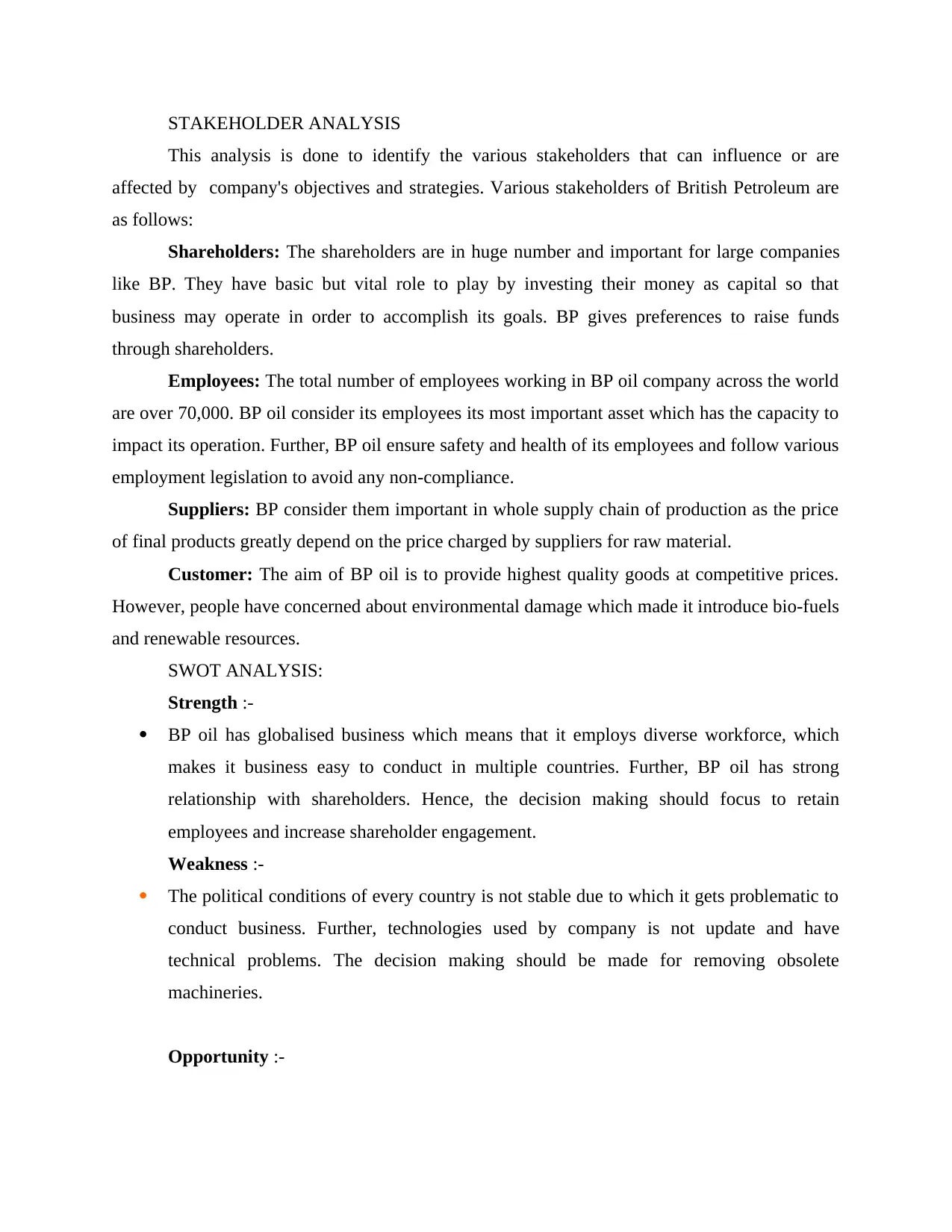
STAKEHOLDER ANALYSIS
This analysis is done to identify the various stakeholders that can influence or are
affected by company's objectives and strategies. Various stakeholders of British Petroleum are
as follows:
Shareholders: The shareholders are in huge number and important for large companies
like BP. They have basic but vital role to play by investing their money as capital so that
business may operate in order to accomplish its goals. BP gives preferences to raise funds
through shareholders.
Employees: The total number of employees working in BP oil company across the world
are over 70,000. BP oil consider its employees its most important asset which has the capacity to
impact its operation. Further, BP oil ensure safety and health of its employees and follow various
employment legislation to avoid any non-compliance.
Suppliers: BP consider them important in whole supply chain of production as the price
of final products greatly depend on the price charged by suppliers for raw material.
Customer: The aim of BP oil is to provide highest quality goods at competitive prices.
However, people have concerned about environmental damage which made it introduce bio-fuels
and renewable resources.
SWOT ANALYSIS:
Strength :-
BP oil has globalised business which means that it employs diverse workforce, which
makes it business easy to conduct in multiple countries. Further, BP oil has strong
relationship with shareholders. Hence, the decision making should focus to retain
employees and increase shareholder engagement.
Weakness :-
The political conditions of every country is not stable due to which it gets problematic to
conduct business. Further, technologies used by company is not update and have
technical problems. The decision making should be made for removing obsolete
machineries.
Opportunity :-
This analysis is done to identify the various stakeholders that can influence or are
affected by company's objectives and strategies. Various stakeholders of British Petroleum are
as follows:
Shareholders: The shareholders are in huge number and important for large companies
like BP. They have basic but vital role to play by investing their money as capital so that
business may operate in order to accomplish its goals. BP gives preferences to raise funds
through shareholders.
Employees: The total number of employees working in BP oil company across the world
are over 70,000. BP oil consider its employees its most important asset which has the capacity to
impact its operation. Further, BP oil ensure safety and health of its employees and follow various
employment legislation to avoid any non-compliance.
Suppliers: BP consider them important in whole supply chain of production as the price
of final products greatly depend on the price charged by suppliers for raw material.
Customer: The aim of BP oil is to provide highest quality goods at competitive prices.
However, people have concerned about environmental damage which made it introduce bio-fuels
and renewable resources.
SWOT ANALYSIS:
Strength :-
BP oil has globalised business which means that it employs diverse workforce, which
makes it business easy to conduct in multiple countries. Further, BP oil has strong
relationship with shareholders. Hence, the decision making should focus to retain
employees and increase shareholder engagement.
Weakness :-
The political conditions of every country is not stable due to which it gets problematic to
conduct business. Further, technologies used by company is not update and have
technical problems. The decision making should be made for removing obsolete
machineries.
Opportunity :-
⊘ This is a preview!⊘
Do you want full access?
Subscribe today to unlock all pages.

Trusted by 1+ million students worldwide
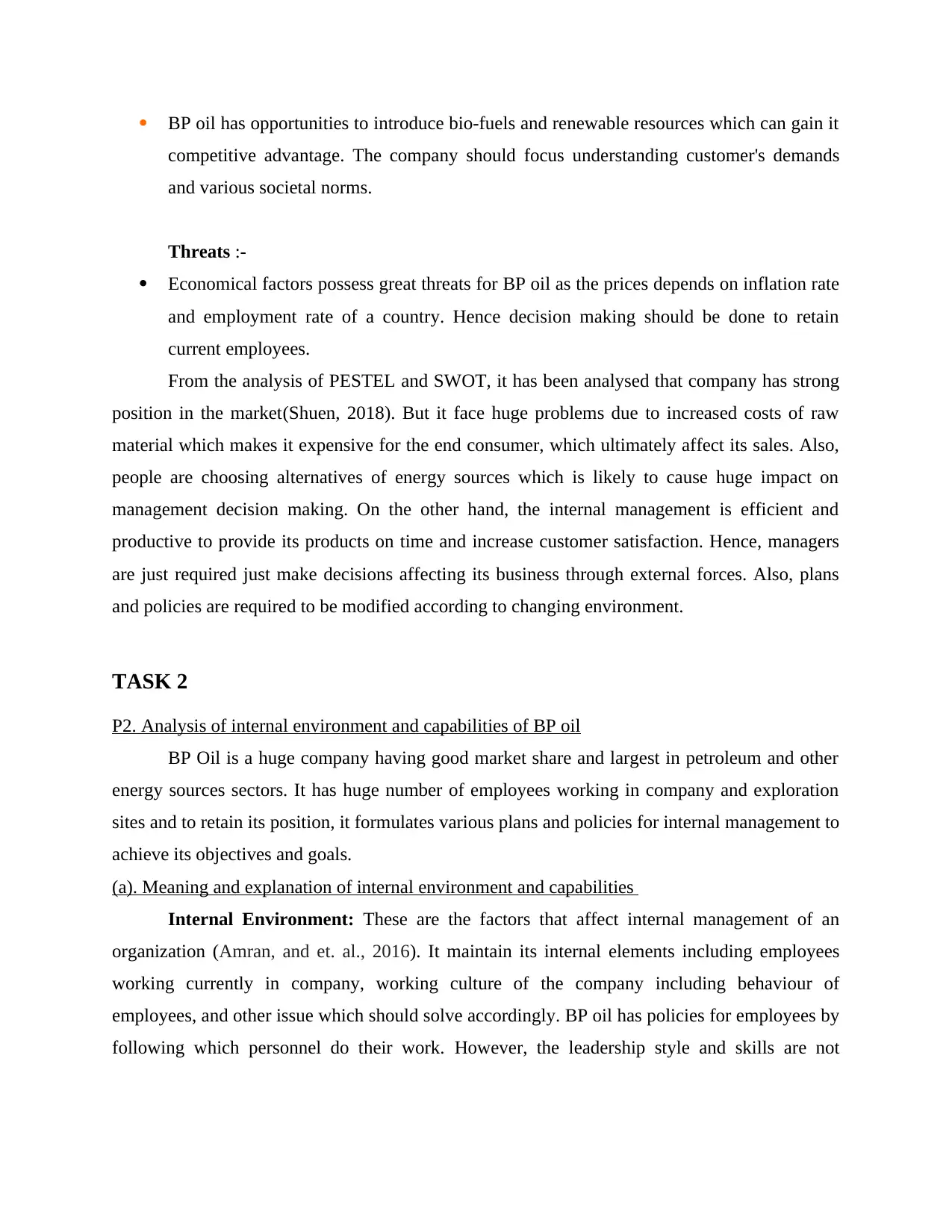
BP oil has opportunities to introduce bio-fuels and renewable resources which can gain it
competitive advantage. The company should focus understanding customer's demands
and various societal norms.
Threats :-
Economical factors possess great threats for BP oil as the prices depends on inflation rate
and employment rate of a country. Hence decision making should be done to retain
current employees.
From the analysis of PESTEL and SWOT, it has been analysed that company has strong
position in the market(Shuen, 2018). But it face huge problems due to increased costs of raw
material which makes it expensive for the end consumer, which ultimately affect its sales. Also,
people are choosing alternatives of energy sources which is likely to cause huge impact on
management decision making. On the other hand, the internal management is efficient and
productive to provide its products on time and increase customer satisfaction. Hence, managers
are just required just make decisions affecting its business through external forces. Also, plans
and policies are required to be modified according to changing environment.
TASK 2
P2. Analysis of internal environment and capabilities of BP oil
BP Oil is a huge company having good market share and largest in petroleum and other
energy sources sectors. It has huge number of employees working in company and exploration
sites and to retain its position, it formulates various plans and policies for internal management to
achieve its objectives and goals.
(a). Meaning and explanation of internal environment and capabilities
Internal Environment: These are the factors that affect internal management of an
organization (Amran, and et. al., 2016). It maintain its internal elements including employees
working currently in company, working culture of the company including behaviour of
employees, and other issue which should solve accordingly. BP oil has policies for employees by
following which personnel do their work. However, the leadership style and skills are not
competitive advantage. The company should focus understanding customer's demands
and various societal norms.
Threats :-
Economical factors possess great threats for BP oil as the prices depends on inflation rate
and employment rate of a country. Hence decision making should be done to retain
current employees.
From the analysis of PESTEL and SWOT, it has been analysed that company has strong
position in the market(Shuen, 2018). But it face huge problems due to increased costs of raw
material which makes it expensive for the end consumer, which ultimately affect its sales. Also,
people are choosing alternatives of energy sources which is likely to cause huge impact on
management decision making. On the other hand, the internal management is efficient and
productive to provide its products on time and increase customer satisfaction. Hence, managers
are just required just make decisions affecting its business through external forces. Also, plans
and policies are required to be modified according to changing environment.
TASK 2
P2. Analysis of internal environment and capabilities of BP oil
BP Oil is a huge company having good market share and largest in petroleum and other
energy sources sectors. It has huge number of employees working in company and exploration
sites and to retain its position, it formulates various plans and policies for internal management to
achieve its objectives and goals.
(a). Meaning and explanation of internal environment and capabilities
Internal Environment: These are the factors that affect internal management of an
organization (Amran, and et. al., 2016). It maintain its internal elements including employees
working currently in company, working culture of the company including behaviour of
employees, and other issue which should solve accordingly. BP oil has policies for employees by
following which personnel do their work. However, the leadership style and skills are not
Paraphrase This Document
Need a fresh take? Get an instant paraphrase of this document with our AI Paraphraser
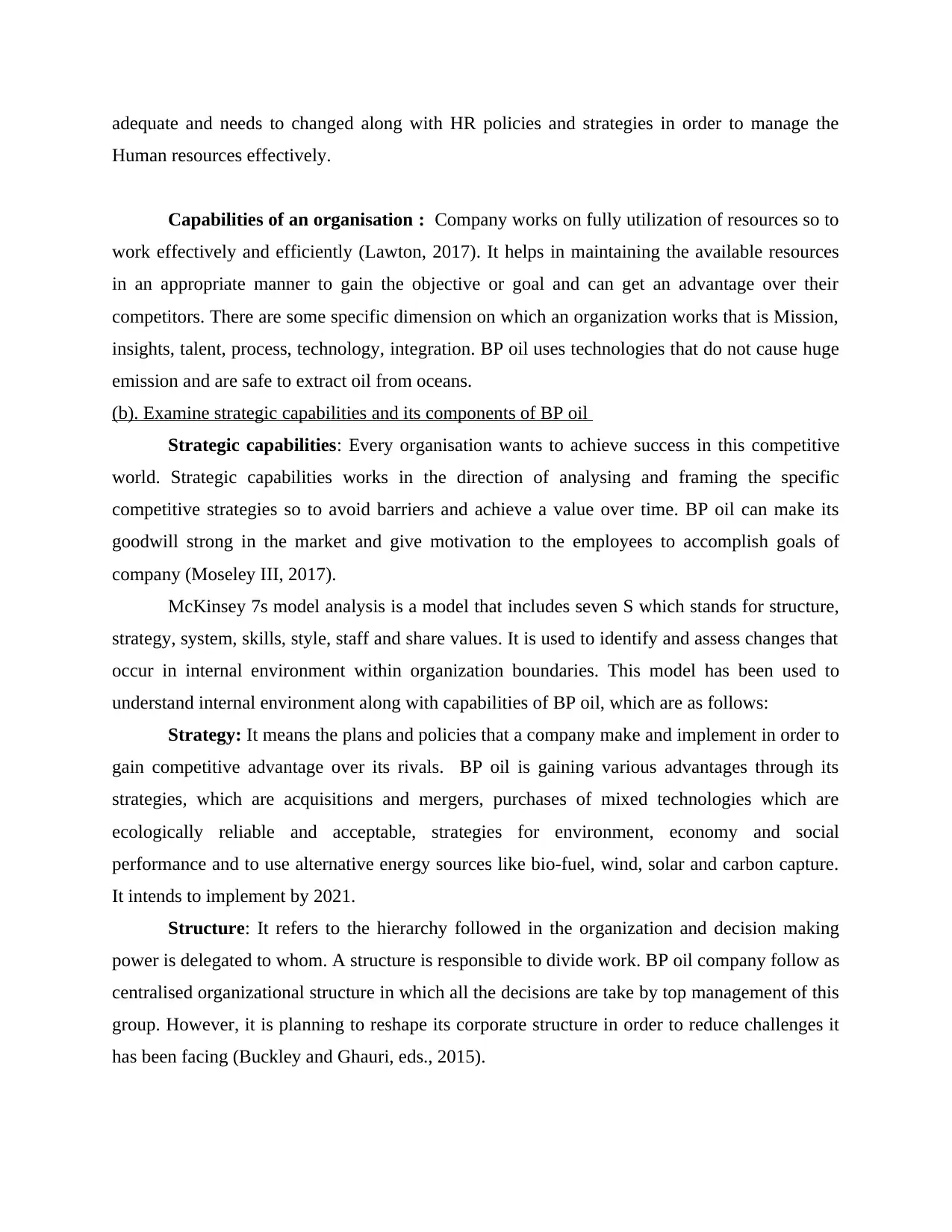
adequate and needs to changed along with HR policies and strategies in order to manage the
Human resources effectively.
Capabilities of an organisation : Company works on fully utilization of resources so to
work effectively and efficiently (Lawton, 2017). It helps in maintaining the available resources
in an appropriate manner to gain the objective or goal and can get an advantage over their
competitors. There are some specific dimension on which an organization works that is Mission,
insights, talent, process, technology, integration. BP oil uses technologies that do not cause huge
emission and are safe to extract oil from oceans.
(b). Examine strategic capabilities and its components of BP oil
Strategic capabilities: Every organisation wants to achieve success in this competitive
world. Strategic capabilities works in the direction of analysing and framing the specific
competitive strategies so to avoid barriers and achieve a value over time. BP oil can make its
goodwill strong in the market and give motivation to the employees to accomplish goals of
company (Moseley III, 2017).
McKinsey 7s model analysis is a model that includes seven S which stands for structure,
strategy, system, skills, style, staff and share values. It is used to identify and assess changes that
occur in internal environment within organization boundaries. This model has been used to
understand internal environment along with capabilities of BP oil, which are as follows:
Strategy: It means the plans and policies that a company make and implement in order to
gain competitive advantage over its rivals. BP oil is gaining various advantages through its
strategies, which are acquisitions and mergers, purchases of mixed technologies which are
ecologically reliable and acceptable, strategies for environment, economy and social
performance and to use alternative energy sources like bio-fuel, wind, solar and carbon capture.
It intends to implement by 2021.
Structure: It refers to the hierarchy followed in the organization and decision making
power is delegated to whom. A structure is responsible to divide work. BP oil company follow as
centralised organizational structure in which all the decisions are take by top management of this
group. However, it is planning to reshape its corporate structure in order to reduce challenges it
has been facing (Buckley and Ghauri, eds., 2015).
Human resources effectively.
Capabilities of an organisation : Company works on fully utilization of resources so to
work effectively and efficiently (Lawton, 2017). It helps in maintaining the available resources
in an appropriate manner to gain the objective or goal and can get an advantage over their
competitors. There are some specific dimension on which an organization works that is Mission,
insights, talent, process, technology, integration. BP oil uses technologies that do not cause huge
emission and are safe to extract oil from oceans.
(b). Examine strategic capabilities and its components of BP oil
Strategic capabilities: Every organisation wants to achieve success in this competitive
world. Strategic capabilities works in the direction of analysing and framing the specific
competitive strategies so to avoid barriers and achieve a value over time. BP oil can make its
goodwill strong in the market and give motivation to the employees to accomplish goals of
company (Moseley III, 2017).
McKinsey 7s model analysis is a model that includes seven S which stands for structure,
strategy, system, skills, style, staff and share values. It is used to identify and assess changes that
occur in internal environment within organization boundaries. This model has been used to
understand internal environment along with capabilities of BP oil, which are as follows:
Strategy: It means the plans and policies that a company make and implement in order to
gain competitive advantage over its rivals. BP oil is gaining various advantages through its
strategies, which are acquisitions and mergers, purchases of mixed technologies which are
ecologically reliable and acceptable, strategies for environment, economy and social
performance and to use alternative energy sources like bio-fuel, wind, solar and carbon capture.
It intends to implement by 2021.
Structure: It refers to the hierarchy followed in the organization and decision making
power is delegated to whom. A structure is responsible to divide work. BP oil company follow as
centralised organizational structure in which all the decisions are take by top management of this
group. However, it is planning to reshape its corporate structure in order to reduce challenges it
has been facing (Buckley and Ghauri, eds., 2015).
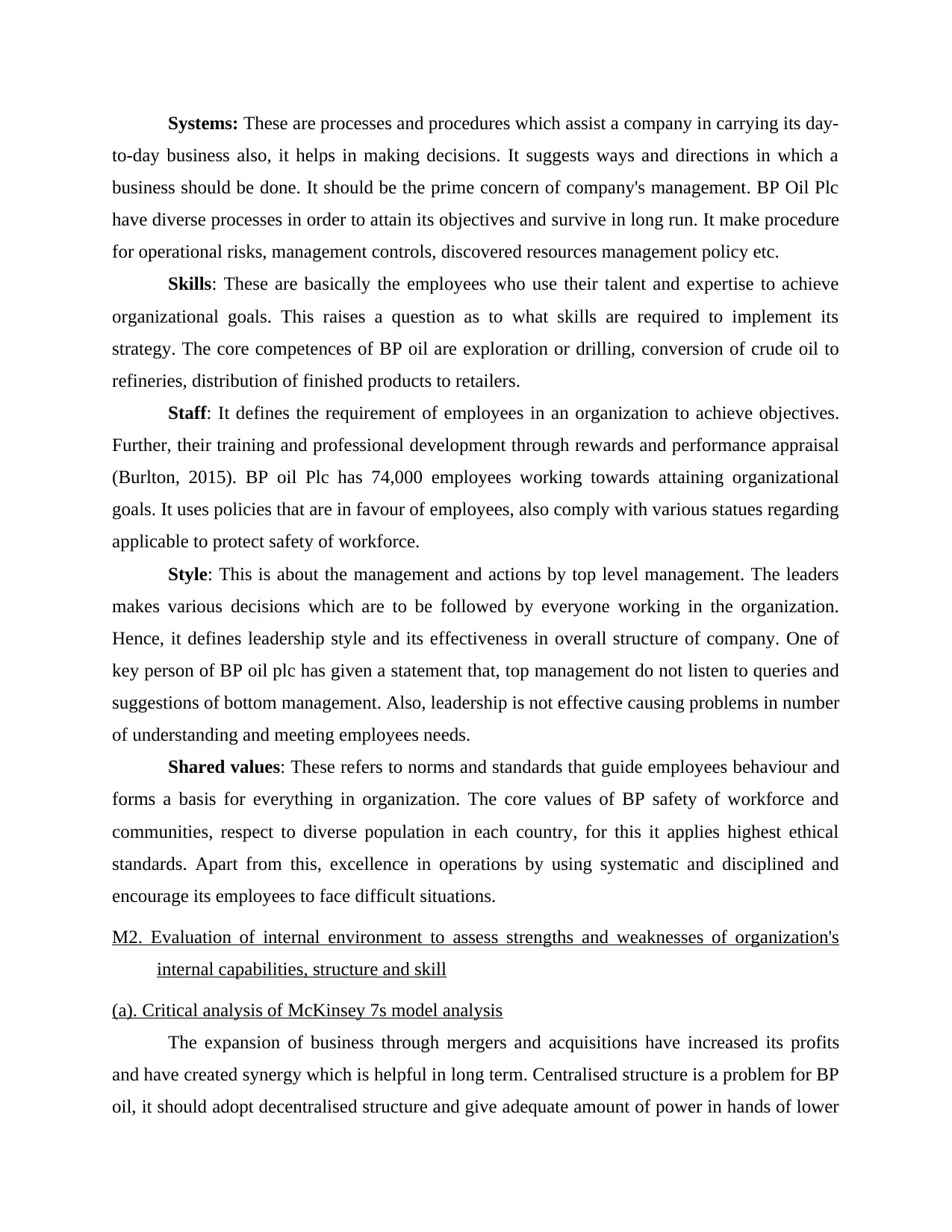
Systems: These are processes and procedures which assist a company in carrying its day-
to-day business also, it helps in making decisions. It suggests ways and directions in which a
business should be done. It should be the prime concern of company's management. BP Oil Plc
have diverse processes in order to attain its objectives and survive in long run. It make procedure
for operational risks, management controls, discovered resources management policy etc.
Skills: These are basically the employees who use their talent and expertise to achieve
organizational goals. This raises a question as to what skills are required to implement its
strategy. The core competences of BP oil are exploration or drilling, conversion of crude oil to
refineries, distribution of finished products to retailers.
Staff: It defines the requirement of employees in an organization to achieve objectives.
Further, their training and professional development through rewards and performance appraisal
(Burlton, 2015). BP oil Plc has 74,000 employees working towards attaining organizational
goals. It uses policies that are in favour of employees, also comply with various statues regarding
applicable to protect safety of workforce.
Style: This is about the management and actions by top level management. The leaders
makes various decisions which are to be followed by everyone working in the organization.
Hence, it defines leadership style and its effectiveness in overall structure of company. One of
key person of BP oil plc has given a statement that, top management do not listen to queries and
suggestions of bottom management. Also, leadership is not effective causing problems in number
of understanding and meeting employees needs.
Shared values: These refers to norms and standards that guide employees behaviour and
forms a basis for everything in organization. The core values of BP safety of workforce and
communities, respect to diverse population in each country, for this it applies highest ethical
standards. Apart from this, excellence in operations by using systematic and disciplined and
encourage its employees to face difficult situations.
M2. Evaluation of internal environment to assess strengths and weaknesses of organization's
internal capabilities, structure and skill
(a). Critical analysis of McKinsey 7s model analysis
The expansion of business through mergers and acquisitions have increased its profits
and have created synergy which is helpful in long term. Centralised structure is a problem for BP
oil, it should adopt decentralised structure and give adequate amount of power in hands of lower
to-day business also, it helps in making decisions. It suggests ways and directions in which a
business should be done. It should be the prime concern of company's management. BP Oil Plc
have diverse processes in order to attain its objectives and survive in long run. It make procedure
for operational risks, management controls, discovered resources management policy etc.
Skills: These are basically the employees who use their talent and expertise to achieve
organizational goals. This raises a question as to what skills are required to implement its
strategy. The core competences of BP oil are exploration or drilling, conversion of crude oil to
refineries, distribution of finished products to retailers.
Staff: It defines the requirement of employees in an organization to achieve objectives.
Further, their training and professional development through rewards and performance appraisal
(Burlton, 2015). BP oil Plc has 74,000 employees working towards attaining organizational
goals. It uses policies that are in favour of employees, also comply with various statues regarding
applicable to protect safety of workforce.
Style: This is about the management and actions by top level management. The leaders
makes various decisions which are to be followed by everyone working in the organization.
Hence, it defines leadership style and its effectiveness in overall structure of company. One of
key person of BP oil plc has given a statement that, top management do not listen to queries and
suggestions of bottom management. Also, leadership is not effective causing problems in number
of understanding and meeting employees needs.
Shared values: These refers to norms and standards that guide employees behaviour and
forms a basis for everything in organization. The core values of BP safety of workforce and
communities, respect to diverse population in each country, for this it applies highest ethical
standards. Apart from this, excellence in operations by using systematic and disciplined and
encourage its employees to face difficult situations.
M2. Evaluation of internal environment to assess strengths and weaknesses of organization's
internal capabilities, structure and skill
(a). Critical analysis of McKinsey 7s model analysis
The expansion of business through mergers and acquisitions have increased its profits
and have created synergy which is helpful in long term. Centralised structure is a problem for BP
oil, it should adopt decentralised structure and give adequate amount of power in hands of lower
⊘ This is a preview!⊘
Do you want full access?
Subscribe today to unlock all pages.

Trusted by 1+ million students worldwide
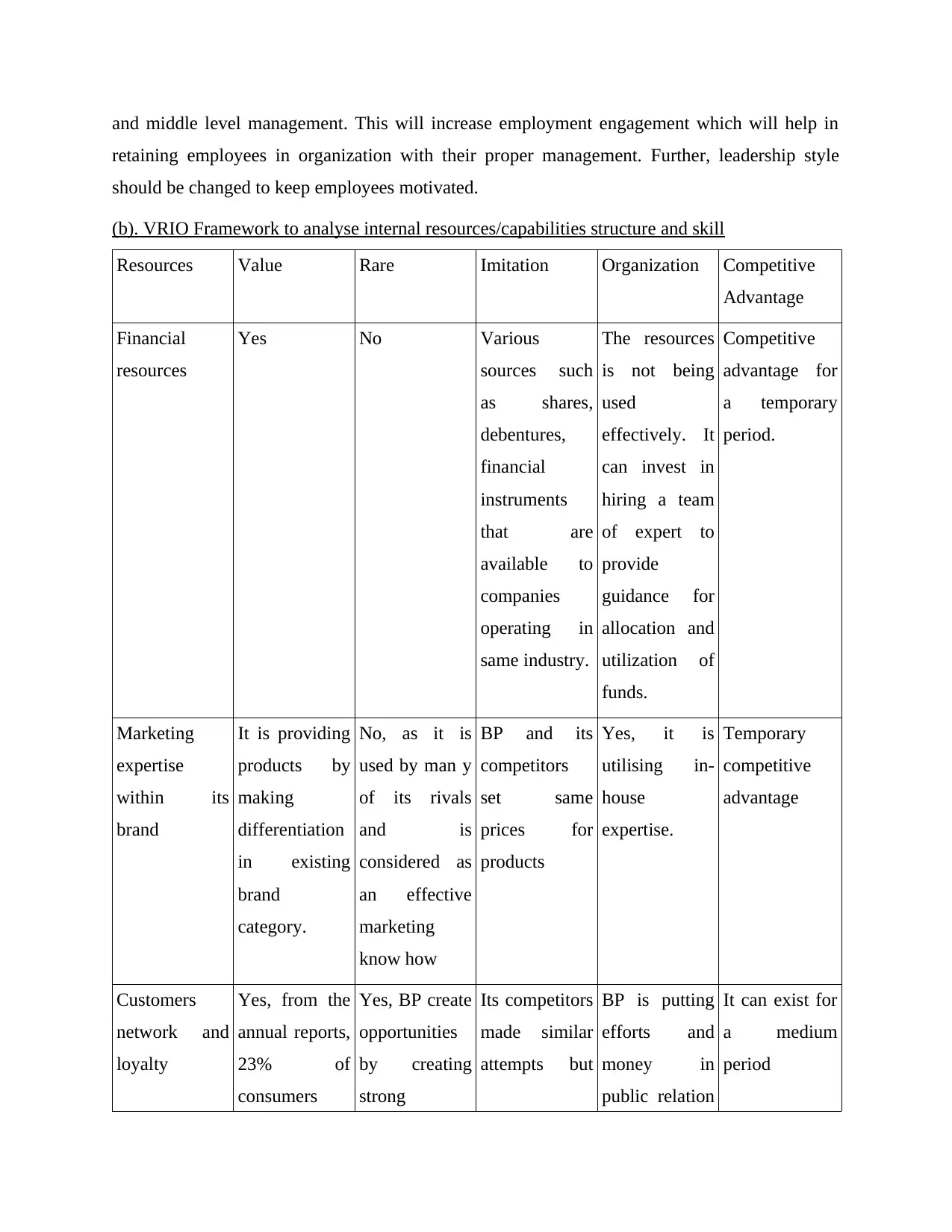
and middle level management. This will increase employment engagement which will help in
retaining employees in organization with their proper management. Further, leadership style
should be changed to keep employees motivated.
(b). VRIO Framework to analyse internal resources/capabilities structure and skill
Resources Value Rare Imitation Organization Competitive
Advantage
Financial
resources
Yes No Various
sources such
as shares,
debentures,
financial
instruments
that are
available to
companies
operating in
same industry.
The resources
is not being
used
effectively. It
can invest in
hiring a team
of expert to
provide
guidance for
allocation and
utilization of
funds.
Competitive
advantage for
a temporary
period.
Marketing
expertise
within its
brand
It is providing
products by
making
differentiation
in existing
brand
category.
No, as it is
used by man y
of its rivals
and is
considered as
an effective
marketing
know how
BP and its
competitors
set same
prices for
products
Yes, it is
utilising in-
house
expertise.
Temporary
competitive
advantage
Customers
network and
loyalty
Yes, from the
annual reports,
23% of
consumers
Yes, BP create
opportunities
by creating
strong
Its competitors
made similar
attempts but
BP is putting
efforts and
money in
public relation
It can exist for
a medium
period
retaining employees in organization with their proper management. Further, leadership style
should be changed to keep employees motivated.
(b). VRIO Framework to analyse internal resources/capabilities structure and skill
Resources Value Rare Imitation Organization Competitive
Advantage
Financial
resources
Yes No Various
sources such
as shares,
debentures,
financial
instruments
that are
available to
companies
operating in
same industry.
The resources
is not being
used
effectively. It
can invest in
hiring a team
of expert to
provide
guidance for
allocation and
utilization of
funds.
Competitive
advantage for
a temporary
period.
Marketing
expertise
within its
brand
It is providing
products by
making
differentiation
in existing
brand
category.
No, as it is
used by man y
of its rivals
and is
considered as
an effective
marketing
know how
BP and its
competitors
set same
prices for
products
Yes, it is
utilising in-
house
expertise.
Temporary
competitive
advantage
Customers
network and
loyalty
Yes, from the
annual reports,
23% of
consumers
Yes, BP create
opportunities
by creating
strong
Its competitors
made similar
attempts but
BP is putting
efforts and
money in
public relation
It can exist for
a medium
period
Paraphrase This Document
Need a fresh take? Get an instant paraphrase of this document with our AI Paraphraser

increases its
sales majorly
customer
loyalty
all were failed campaigns.
Co-ordination
of overall
activities with
BP oil
corporate
strategy
YES NO These are
individual and
different in
case of each
firm
It has used
strategies and
conducted
sessions and
seminars to
make
employees
understand
requirements
of company.
Provides ocean
of
opportunities
to have long
term
sustainability.
Vision of
leadership for
future
challenges
Yes No It can not be
followed by
competitors as
BP has own
set of
strategies
Meeting of top
management
with all
leaders should
be done once
in every 6
months to
assess the
effectiveness
of their
leadership.
Strong and
long-term
competitive
advantage
Distribution
and Logistics
Costs
Competitivene
ss
Yes, it reduces
costs involved
in supply
chain and
transportation
No Rivals can
follow same
strategy,
however, it is
not that easy
Yes. Company
can invest to
buy more
transportation
vehicles to
avoid any
delay.
Medium to
long term
competitive
advantage
sales majorly
customer
loyalty
all were failed campaigns.
Co-ordination
of overall
activities with
BP oil
corporate
strategy
YES NO These are
individual and
different in
case of each
firm
It has used
strategies and
conducted
sessions and
seminars to
make
employees
understand
requirements
of company.
Provides ocean
of
opportunities
to have long
term
sustainability.
Vision of
leadership for
future
challenges
Yes No It can not be
followed by
competitors as
BP has own
set of
strategies
Meeting of top
management
with all
leaders should
be done once
in every 6
months to
assess the
effectiveness
of their
leadership.
Strong and
long-term
competitive
advantage
Distribution
and Logistics
Costs
Competitivene
ss
Yes, it reduces
costs involved
in supply
chain and
transportation
No Rivals can
follow same
strategy,
however, it is
not that easy
Yes. Company
can invest to
buy more
transportation
vehicles to
avoid any
delay.
Medium to
long term
competitive
advantage
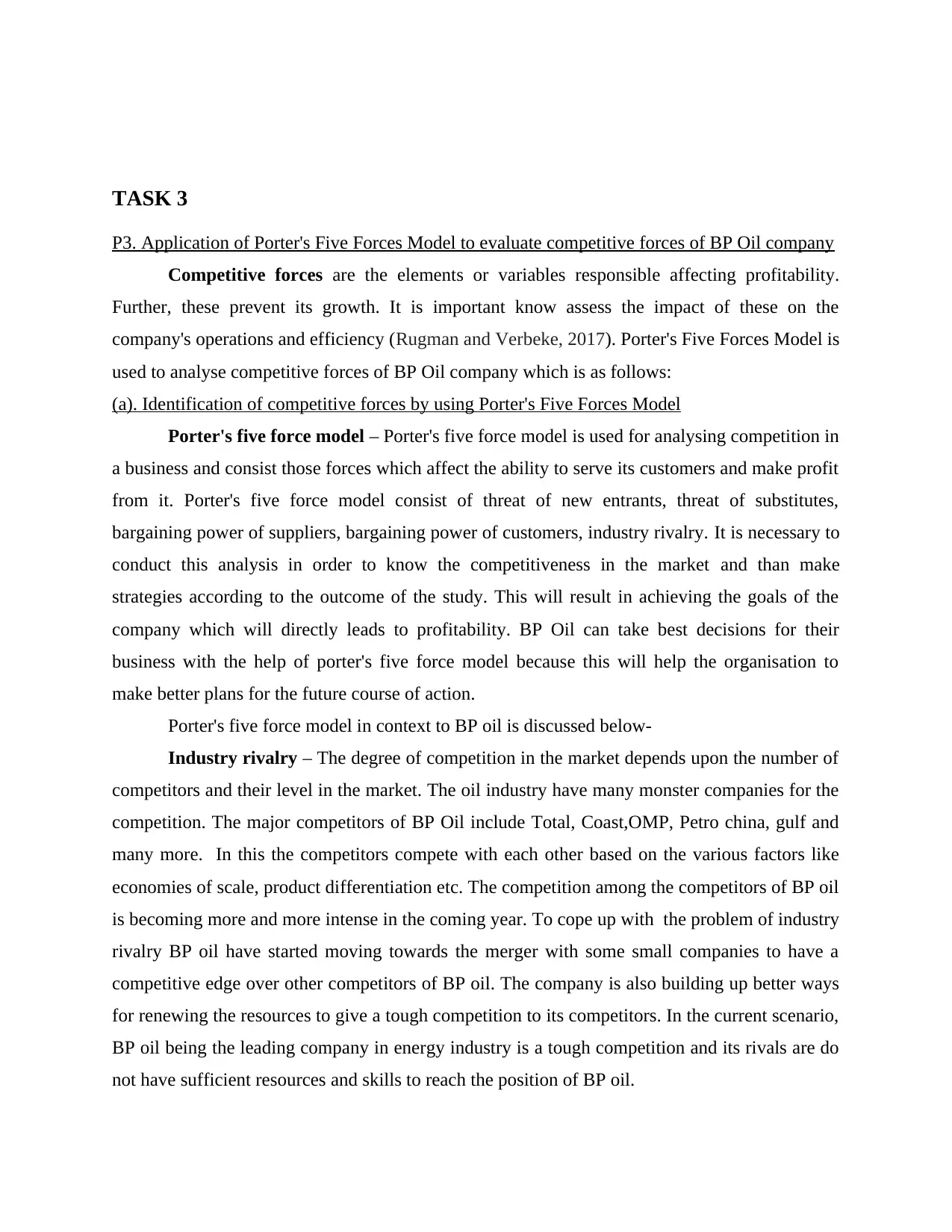
TASK 3
P3. Application of Porter's Five Forces Model to evaluate competitive forces of BP Oil company
Competitive forces are the elements or variables responsible affecting profitability.
Further, these prevent its growth. It is important know assess the impact of these on the
company's operations and efficiency (Rugman and Verbeke, 2017). Porter's Five Forces Model is
used to analyse competitive forces of BP Oil company which is as follows:
(a). Identification of competitive forces by using Porter's Five Forces Model
Porter's five force model – Porter's five force model is used for analysing competition in
a business and consist those forces which affect the ability to serve its customers and make profit
from it. Porter's five force model consist of threat of new entrants, threat of substitutes,
bargaining power of suppliers, bargaining power of customers, industry rivalry. It is necessary to
conduct this analysis in order to know the competitiveness in the market and than make
strategies according to the outcome of the study. This will result in achieving the goals of the
company which will directly leads to profitability. BP Oil can take best decisions for their
business with the help of porter's five force model because this will help the organisation to
make better plans for the future course of action.
Porter's five force model in context to BP oil is discussed below-
Industry rivalry – The degree of competition in the market depends upon the number of
competitors and their level in the market. The oil industry have many monster companies for the
competition. The major competitors of BP Oil include Total, Coast,OMP, Petro china, gulf and
many more. In this the competitors compete with each other based on the various factors like
economies of scale, product differentiation etc. The competition among the competitors of BP oil
is becoming more and more intense in the coming year. To cope up with the problem of industry
rivalry BP oil have started moving towards the merger with some small companies to have a
competitive edge over other competitors of BP oil. The company is also building up better ways
for renewing the resources to give a tough competition to its competitors. In the current scenario,
BP oil being the leading company in energy industry is a tough competition and its rivals are do
not have sufficient resources and skills to reach the position of BP oil.
P3. Application of Porter's Five Forces Model to evaluate competitive forces of BP Oil company
Competitive forces are the elements or variables responsible affecting profitability.
Further, these prevent its growth. It is important know assess the impact of these on the
company's operations and efficiency (Rugman and Verbeke, 2017). Porter's Five Forces Model is
used to analyse competitive forces of BP Oil company which is as follows:
(a). Identification of competitive forces by using Porter's Five Forces Model
Porter's five force model – Porter's five force model is used for analysing competition in
a business and consist those forces which affect the ability to serve its customers and make profit
from it. Porter's five force model consist of threat of new entrants, threat of substitutes,
bargaining power of suppliers, bargaining power of customers, industry rivalry. It is necessary to
conduct this analysis in order to know the competitiveness in the market and than make
strategies according to the outcome of the study. This will result in achieving the goals of the
company which will directly leads to profitability. BP Oil can take best decisions for their
business with the help of porter's five force model because this will help the organisation to
make better plans for the future course of action.
Porter's five force model in context to BP oil is discussed below-
Industry rivalry – The degree of competition in the market depends upon the number of
competitors and their level in the market. The oil industry have many monster companies for the
competition. The major competitors of BP Oil include Total, Coast,OMP, Petro china, gulf and
many more. In this the competitors compete with each other based on the various factors like
economies of scale, product differentiation etc. The competition among the competitors of BP oil
is becoming more and more intense in the coming year. To cope up with the problem of industry
rivalry BP oil have started moving towards the merger with some small companies to have a
competitive edge over other competitors of BP oil. The company is also building up better ways
for renewing the resources to give a tough competition to its competitors. In the current scenario,
BP oil being the leading company in energy industry is a tough competition and its rivals are do
not have sufficient resources and skills to reach the position of BP oil.
⊘ This is a preview!⊘
Do you want full access?
Subscribe today to unlock all pages.

Trusted by 1+ million students worldwide
1 out of 20
Related Documents
Your All-in-One AI-Powered Toolkit for Academic Success.
+13062052269
info@desklib.com
Available 24*7 on WhatsApp / Email
![[object Object]](/_next/static/media/star-bottom.7253800d.svg)
Unlock your academic potential
Copyright © 2020–2025 A2Z Services. All Rights Reserved. Developed and managed by ZUCOL.

